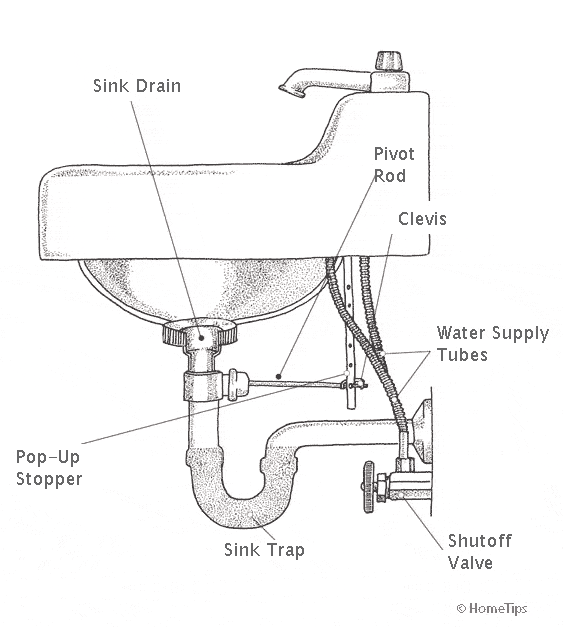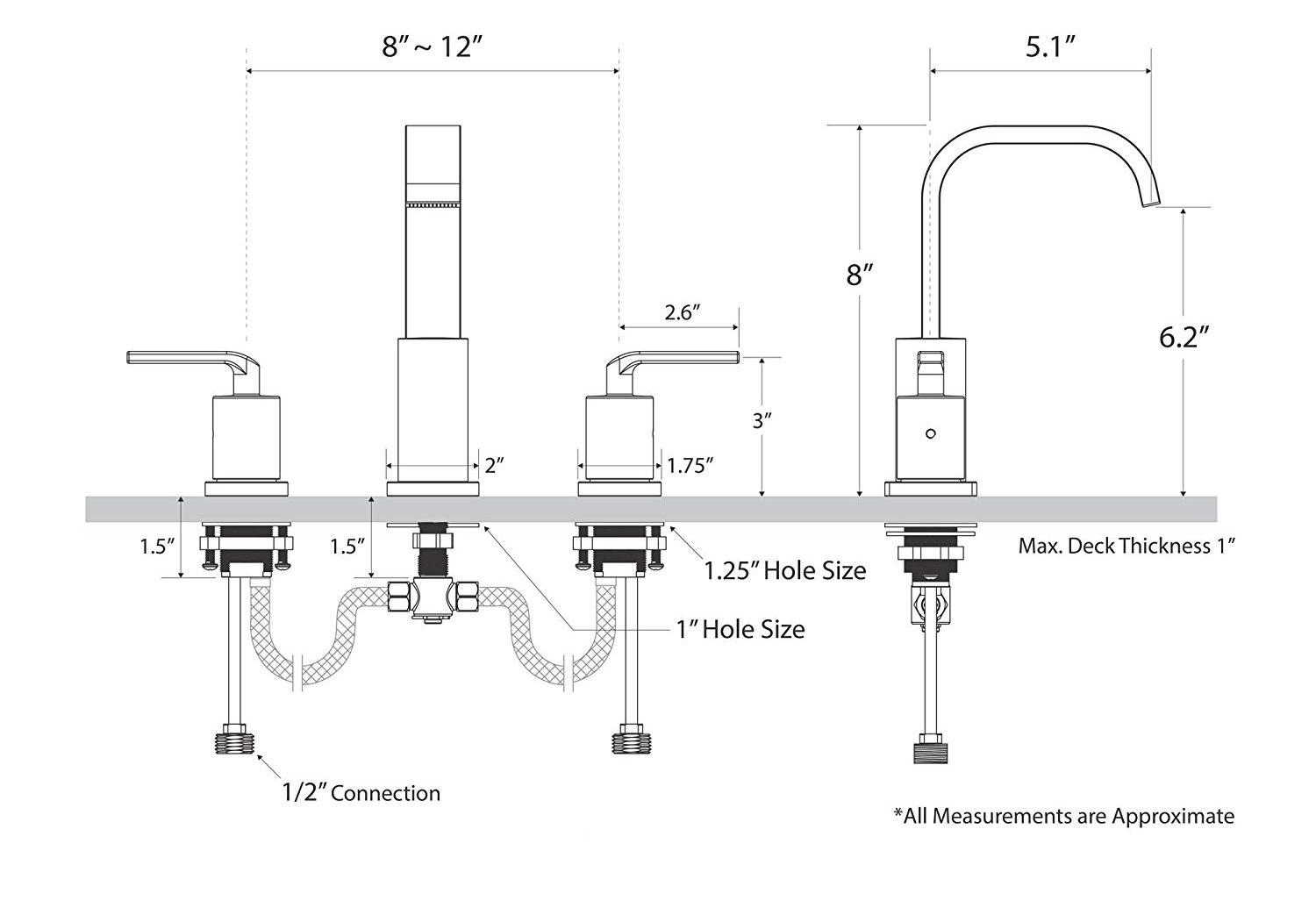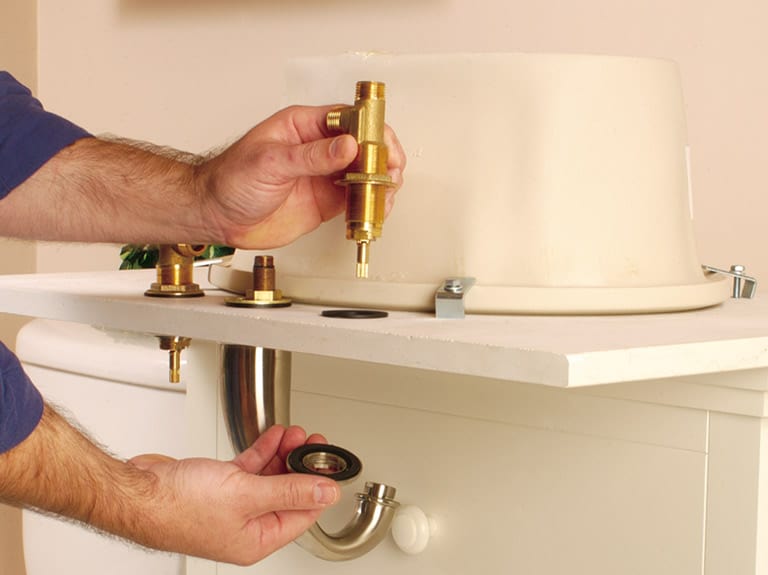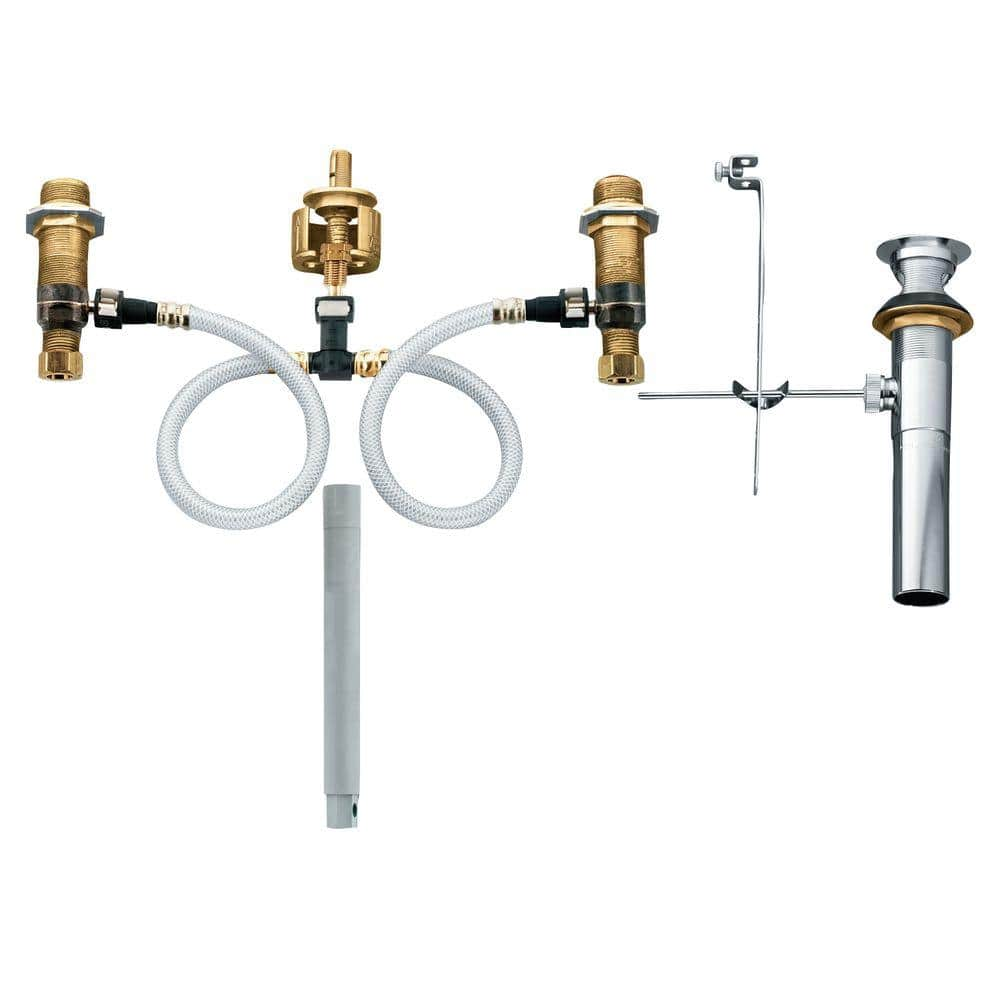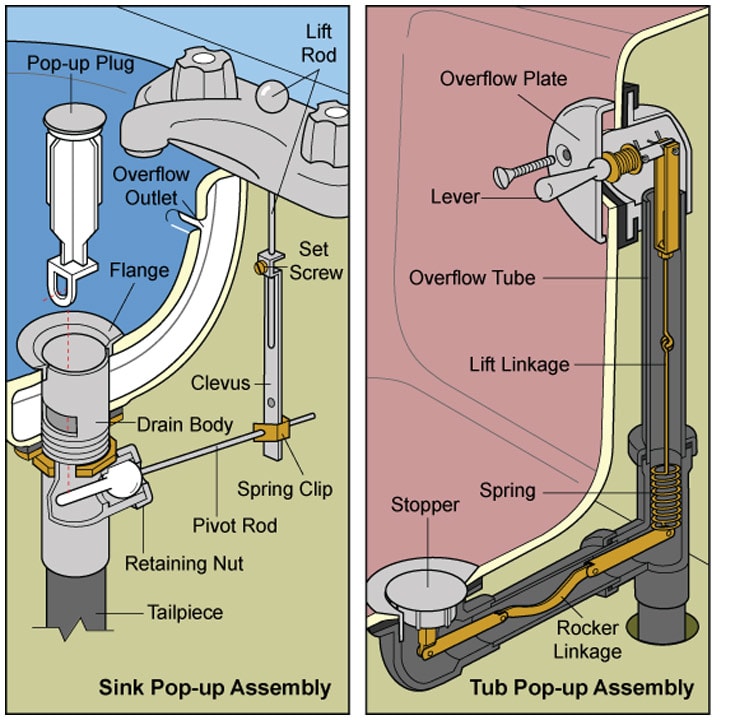How Bathroom Sink Faucet Plumbing Works
Bathroom sink faucet plumbing is an essential component of any bathroom. Understanding how it works can help you troubleshoot issues and make informed decisions when it comes to repairs or upgrades. Let’s discuss the basics of bathroom sink faucet plumbing and explore the key elements that make it function seamlessly.
- Water Supply Lines: Water supply lines are the primary components responsible for delivering water to your bathroom sink faucet. Typically, there are two separate lines, one for hot water and one for cold water. These lines are connected to the main water supply and are controlled by shut-off valves located beneath the sink. Understanding how these supply lines function and how to shut them off in case of emergencies is crucial.
- Valve Mechanisms: The valve mechanisms control the flow and temperature of the water. There are different types of valve mechanisms, including compression valves, ball valves, and cartridge valves. Each type has its unique way of regulating the water flow and temperature. Understanding how these mechanisms work can help you identify and fix issues such as leaks or inconsistent water temperature.
- Drainage System: The drainage system is another important aspect of bathroom sink faucet plumbing. It ensures that the used water is efficiently carried away. The drainage system consists of a drainpipe, a p-trap, and a vent pipe. It is essential to keep the drainage system clean and free from clogs to prevent water backup and unpleasant odors.
- Aerators: Aerators are small attachments located at the end of the faucet spout. They help regulate the water flow by introducing air into the stream. Not only do aerators conserve water by reducing the flow rate, but they also prevent splashing and provide a smoother water stream. Understanding how aerators function and how to clean or replace them can improve the overall efficiency of your bathroom sink faucet.
- Shut-Off Valves: Shut-off valves, as mentioned earlier, are located beneath the sink and control the water supply to the faucet. These valves are crucial for maintenance and repairs. Knowing how to properly shut off the water supply using these valves can prevent water damage and make any necessary repairs or replacements easier.
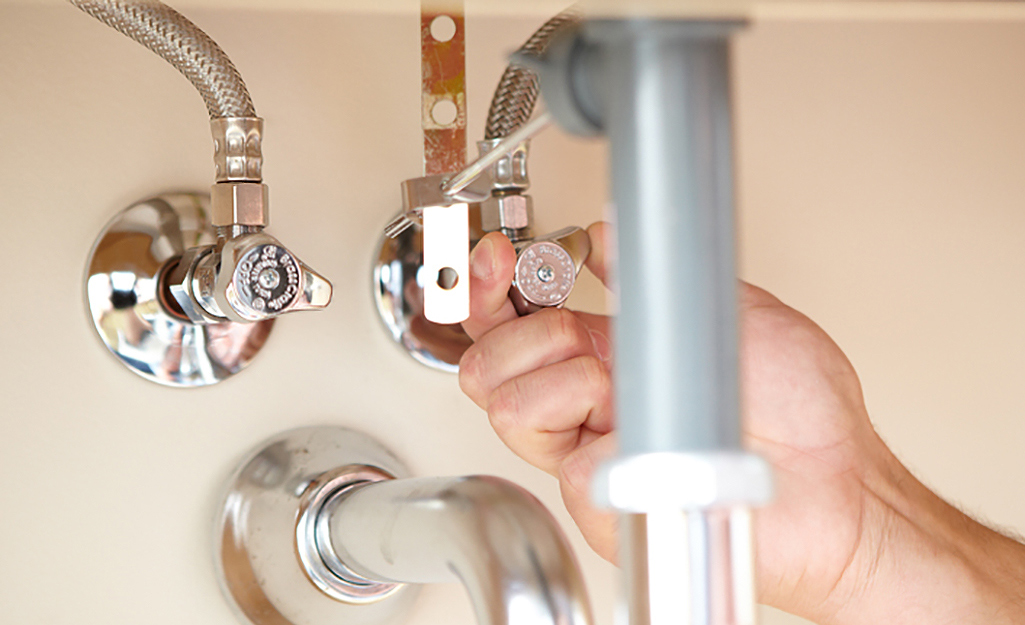
Common Issues and Troubleshooting
Dealing with leaks and drips in your bathroom sink faucet can be frustrating. Not only can they waste water, but they can also lead to water damage if left untreated. Let’s talk about some of the most common issues related to bathroom sink faucet plumbing, along with troubleshooting tips to help you fix leaks and drips effectively.
Leaking Faucet: A leaking faucet is a common issue that can be caused by various factors, such as worn-out washers, loose connections, or damaged valve seats. To fix a leaking faucet, start by turning off the water supply using the shut-off valves. Then, disassemble the faucet and inspect the components for any signs of damage. Replace worn-out parts, tighten loose connections, and ensure a proper seal to eliminate the leak.
Dripping Faucet: A dripping faucet is not only annoying but can also waste a significant amount of water over time. The most common cause of a dripping faucet is a faulty or worn-out cartridge or valve. To troubleshoot a dripping faucet, start by turning off the water supply. Disassemble the faucet and inspect the cartridge or valve for any signs of wear or damage. If necessary, replace the faulty component to stop the drip.
Low Water Pressure: Low water pressure can be a frustrating issue, especially when it comes to bathroom sink faucets. It can be caused by various factors, including mineral buildup, clogged aerators, or a faulty pressure regulator. To address low water pressure, start by removing and cleaning the aerator. If that doesn’t solve the issue, check for any blockages in the supply lines or consider calling a professional to inspect and repair the pressure regulator.
Uneven Water Temperature: Inconsistent water temperature can make your daily routine uncomfortable. This issue is often caused by a faulty mixing valve or an issue with the hot water supply. To troubleshoot uneven water temperature, start by checking if the hot water supply is working correctly. If the hot water is fine, the issue may lie in the mixing valve. Consider replacing the mixing valve or calling a professional plumber for assistance.
Choosing the Right Faucet
Choosing the right bathroom sink faucet is an important decision that impacts both functionality and aesthetics. With so many options available in the market, it can be overwhelming to select the perfect faucet for your needs. Let’s explore the different types, styles, and materials used in bathroom sink faucets to help you make an informed choice.
Faucet Types: There are three main types of bathroom sink faucets – single-handle, two-handle, and pull-down faucets. Single-handle faucets allow you to control water flow and temperature with one lever or handle. Two-handle faucets have separate handles or levers to control hot and cold water. Pull-down faucets feature a retractable hose that makes it easier to fill pots or clean large items.
Styles: Faucet styles range from traditional to modern. Popular styles include bridge, widespread, centerset, vessel, wall-mounted, and pedestal. Bridge and widespread faucets have spouts that extend from the deck while centerset and vessel styles have spouts located above the sink basin. Consider your sink type and bathroom aesthetic when choosing a style.
Materials: Common faucet materials are metal, ceramic, and plastic. Metal faucets made of brass or stainless steel are durable but heavier. Ceramic faucets are lightweight and have a glossy, elegant finish. Plastic or composite faucets are affordable and corrosion-resistant but less durable. Choose materials based on your budget and maintenance needs.
Additional Features: Beyond the basics, faucets offer features like pull-down sprayers, touchless sensors, temperature memory settings, and water filtration systems. Consider if you need any of these convenience features before making a selection. Hands-free faucets are ideal for families with kids or those concerned about hygiene.
Finish: Faucet finishes range from polished chrome to matte black, oil-rubbed bronze, and more. Stick to popular finishes that complement your existing fixtures for a cohesive look. Darker finishes hide water spots better but are harder to keep clean. Chrome, stainless steel, and polished nickel finishes showcase watermarks.
Handles/Levers: Handles and levers come in a variety of styles, including cross handles, lever handles, knob handles, and touch-sensitive controls. Consider the ergonomics and ease of use when choosing the type of handle or lever. Cross handles have a classic look, while lever handles are easy to operate. Touch-sensitive controls offer a modern and futuristic touch.
Budget: Set a budget for your bathroom sink faucet and stick to it. Faucets come in a wide price range, and while it’s tempting to splurge on a fancy design, consider the long-term value and functionality. Look for faucets with good warranties and reputable brands to ensure quality and durability.
Water Efficiency: Another important factor to consider is water efficiency. Look for faucets with the WaterSense label, which indicates that they meet the EPA’s water efficiency standards. These faucets are designed to conserve water without compromising performance, helping you save on your water bills and reduce your environmental impact.
Installing a Bathroom Sink Faucet
Installing a bathroom sink faucet can seem like a daunting task, but with the right tools and a step-by-step guide, it can be a rewarding DIY project. Below we provide you with a detailed guide on how to install a bathroom sink faucet yourself, saving you money on professional installation costs.
Gather the Tools and Materials: Before you begin the installation process, gather all the necessary tools and materials. You will need an adjustable wrench, pliers, plumber’s putty, Teflon tape, a bucket or towel, and the new faucet kit. Ensure you have the correct size and type of faucet for your sink.
Turn Off the Water Supply: Start by turning off the water supply to the sink. Locate the shut-off valves beneath the sink and turn them clockwise until they are fully closed. Test the water flow to ensure it has been successfully shut off.
Disconnect the Existing Faucet: To remove the old faucet, start by disconnecting the supply lines. Use an adjustable wrench to loosen the nuts connecting the supply lines to the faucet. Place a bucket or towel beneath the sink to catch any water that may spill. Once the supply lines are disconnected, use pliers to loosen the nuts securing the faucet to the sink. Remove the old faucet and clean the sink surface thoroughly.
Apply Plumber’s Putty or Teflon Tape: If your new faucet requires the use of a plumber’s putty, apply a thin layer of putty around the base of the faucet. If the instructions recommend Teflon tape, wrap the tape around the threads of the faucet. These measures help create a watertight seal.
Install the New Faucet: Position the new faucet in the mounting holes on the sink. From beneath the sink, secure the faucet in place using the provided nuts and washers. Use pliers to tighten the nuts, ensuring the faucet is stable and centered on the sink.
Connect the Supply Lines: Attach the hot and cold supply lines to the corresponding valves on the faucet. Use an adjustable wrench to tighten the nuts, ensuring a secure connection. Wrap Teflon tape around the threads of the supply lines before attaching them to the faucet for added leak protection.
Test for Leaks and Reassemble: Once the supply lines are connected, turn on the water supply. Check for any leaks around the connections and make any necessary adjustments. Once you are confident there are no leaks, reassemble any components that were removed during the installation process, such as the aerator.
Modern Features and Technology for Bathroom Sink Faucets
Upgrading your bathroom sink faucet not only enhances the aesthetics of your space but also provides an opportunity to incorporate modern features and technology. Below are some of the innovative features available in modern bathroom sink faucets, allowing you to elevate both the functionality and style of your plumbing system.
Touchless Operation: Touchless faucets have gained popularity due to their convenience and hygienic benefits. These faucets use motion sensors to detect hand movements and automatically turn on and off the water flow. Touchless operation reduces the spread of germs and makes it easier to use the faucet when your hands are full or dirty.
Temperature Control: Some modern bathroom sink faucets offer advanced temperature control features. These faucets allow you to set and maintain a specific water temperature, ensuring a comfortable and consistent flow every time you use the faucet. Temperature control features are particularly useful for households with children or elderly individuals who may have difficulty adjusting the water temperature manually.
Water Conservation: Water conservation is a significant concern in today’s world. Many modern bathroom sink faucets come with water-saving features that help reduce water consumption without compromising performance. These features include aerators, which introduce air into the water stream to maintain a strong flow while using less water, and flow restrictors, which limit water flow to a specific rate.
LED Lighting: LED lighting has become a popular feature in modern bathroom sink faucets. These faucets incorporate LED lights that change color based on the water temperature, adding a visual element to your sink area. LED lighting not only enhances the aesthetics of your bathroom but also provides a practical indication of the water temperature, preventing accidental burns.
Smart Technology Integration: With the rise of smart homes, bathroom sink faucets are now being integrated with smart technology. These faucets can be controlled remotely through smartphone apps or voice assistants, allowing you to adjust water flow, temperature, and other settings with ease. Smart faucets can also provide usage data, such as water consumption and usage patterns, helping you make informed decisions for water conservation.
Easy Maintenance and Cleaning: Modern bathroom sink faucets often incorporate features that make maintenance and cleaning a breeze. For example, some faucets have a magnetic docking system for the pull-down sprayer, ensuring a secure fit and easy retraction. Additionally, certain finishes and materials are resistant to fingerprints, water spots, and corrosion, reducing the need for frequent cleaning and maintenance.
Installation Instructions For Therma Bathroom Sink Faucet
How to Replace a Bathroom Faucet
How to Install a Bathroom Faucet
How to Install or Replace a Bathroom Faucet RONA
Anatomy of a sink Plumbing installation, Diy plumbing, Plumbing
How to Install a Bathroom Faucet A DIY Guide
MOEN Widespread Bathroom Faucet Rough-In Valve with Drain Assembly – 1/2 in. IPS Connection 9000
Bathroom Faucet, 2 Handle Widespread Bathroom Faucets
Related Posts:
